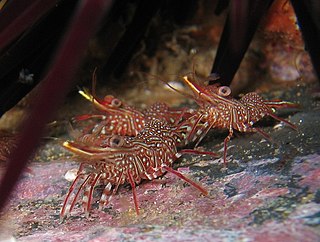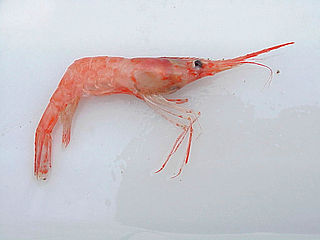
Hippolytidae is a family of cleaner shrimp, also known as broken-back shrimp or anemone shrimp. The term "broken-back shrimp" also applies to the genus Hippolyte in particular and "cleaner shrimp" is sometimes applied exclusively to Lysmata amboinensis.

The family Rhynchocinetidae are a group of small, reclusive red-and-white shrimp. This family typically has an upward-hinged foldable rostrum, hence its taxon name Rhynchocinetidae, which means movable beak; this gives these shrimps their common name of hinge-beak shrimps. The family contains only two genera, Cinetorhynchus and Rhynchocinetes.

The family Pandalidae is a taxon of caridean shrimp. These species are commonly called pandalid shrimp. They are edible and have high economic value. They are characterised by the subdivided carpus of the second pereiopod and, mainly, by the lack of the chelae (claws) on the first pereiopod. This is a cold-water family, and their representation in tropical areas is made by deep-sea shrimp. The genus Physetocaris, sometimes placed in this family, is now considered to be in its own family, Physetocarididae.

Lipke Bijdeley Holthuis was a Dutch carcinologist, considered one of the "undisputed greats" of carcinology, and "the greatest carcinologist of our time".
Athanas is a genus of shrimp of the family Alpheidae. These are small shrimp measuring 2 cm in length. Females have smaller chelae than males.

Palaemonetes, its common names include glass shrimp, ghost shrimp, feeder shrimp, is a genus of caridean shrimp comprising a geographically diverse group of fresh water, brackish and marine crustaceans. Conventionally, Palaemonetes included the following species:

Hippolyte is a genus of shrimp of the family Hippolytidae, containing the following species:

Rhynchocinetes is a genus of shrimp, containing the following 14 species:

Lebbeus is a genus of shrimp in the family Hippolytidae. It includes a species whose name was auctioned in 2009 to raise funds for conservation; Luc Longley won with a bid of A$3,600. He named the shrimp Lebbeus clarehannah. The following species are included:

Scyllarides latus, the Mediterranean slipper lobster, is a species of slipper lobster found in the Mediterranean Sea and in the eastern Atlantic Ocean. It is edible and highly regarded as food, but is now rare over much of its range due to overfishing. Adults may grow to 1 foot (30 cm) long, are camouflaged, and have no claws. They are nocturnal, emerging from caves and other shelters during the night to feed on molluscs. As well as being eaten by humans, S. latus is also preyed upon by a variety of bony fish. Its closest relative is S. herklotsii, which occurs off the Atlantic coast of West Africa; other species of Scyllarides occur in the western Atlantic Ocean and the Indo-Pacific. The larvae and young animals are largely unknown.

Macrobrachium is a genus of freshwater prawns or shrimps characterised by the extreme enlargement of the second pair of pereiopods, at least in the male.

Lysmata is a genus of shrimp in the infraorder Caridea, the caridean shrimp. The genus belongs to the family Lysmatidae. Lysmata are popular ornamental shrimp in the marine aquarium trade for their bright color patterns, interesting behaviors, and ability to control certain aquarium pests such as sea anemones of the genus Aiptasia. They are known to command high prices on the pet market.

Cuapetes is a genus of shrimp in the family Palaemonidae, comprising the following species:

Rhynchocinetes durbanensis, commonly known as the camel shrimp and the hingebeak prawn, is a species of shrimp found in the Indo-Pacific. Up to 4 cm (1.6 in) in length, the shrimp has large black eyes, and features red and white lines on a translucent body. It has many white ocelli (spots) as well as a Y-shaped white mark on the upper front part of its carapace. It is strongly sexually dimorphic, and dominant males have larger first pair of chelipeds. The shrimp is found in hollows and crevices from 5 to 35 metres deep, where it forms groups consisting of dozens of individuals. One study determined that the ovigerous females carry from 267 to 1764 eggs, and the eggs take 9 days to hatch after spawning at a temperature of 29.2 °C (84.6 °F), or 18 days when the temperature is under 22.0 °C (71.6 °F). R. durbanensis has been frequently confused with R. uritai, and also closely resembles R. brucei. R. durbanensis was first described scientifically by Isabella Gordon in 1936.
Palaemonella is a genus of shrimp in the family Palaemonidae, containing the following species:

Cinetorhynchus reticulatus is a species of shrimp belonging to the family Rhynchocinetidae, known by the common name green-eye dancing shrimp or reticulated hinge-beak shrimp.
Periclimenaeus is a genus of decapod crustaceans of the family Palaemonidae which is part of the infraorder Caridea. The genus was named by the English carcinologist Lancelot Alexander Borradaile in 1915. He set out the distinguishing features of the genus as:
Body rather stout, cephalothorax deep, a good deal compressed, abdomen greatly curved Thorax without dorsal swelling. Rostrum rather short, compressed, toothed above only. Outer antennular flagellum not deeply cleft. Antennal scale of good breadth. Mandible without palp. Second maxilliped without podopalp. Third maxilliped narrow, with vestigial arthrobranch.

Periclimenes, commonly known as glass shrimp or cleaner shrimp, is a commensal and often symbiotic genus of semi-transparent shrimp within the family Palaemonidae. Species of this large genus feature a wide variety of coloration and patterns, widespread distribution throughout much of the world's tropical oceans, and are often sought out for aquarium trade.

Cinetorhynchus rigens is a species of shrimp in the family Rhynchocinetidae. Common names include mechanical shrimp, Atlantic dancing shrimp, red night shrimp and red coral shrimp. It occurs in shallow water in the tropical Atlantic Ocean.














